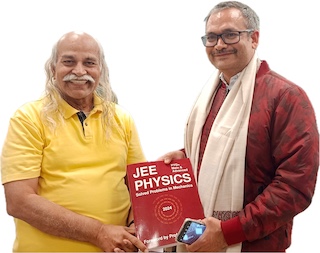Concave lens
The focal length of a convex lens can be easily found by measuring the image distance, the object distance and applying the lens formula. This is possible because convex lens is a converging lens and forms real images for real objects beyond its focus. This real image can be taken on a screen.
Concave lens on the other hand is a diverging lens which forms virtual images for real objects. These virtual images cannot be taken on a screen. So we have to devise some other method to find the focal length of a concave lens.
In this experiment we find the focal length of a concave lens using a light box. The light box can create nearly parallel beams of light. We trace the path of these rays through the lens.
Procedure
You need a concave lens, light box, a transformer, a wooden board (or cardboard) having a white base with a groove, pencil and scale.
Note: Light box is a special equipment designed by Anveshika. It has three slits. The light box contains a 12 V bulb. The power to the bulb is provided by a 220 V to 12 V step down transformer. The light from the bulb passes through a lens and comes out as three parallel beams from the slits. We can close a slit by putting a black tape over it.
- Place the concave lens in the groove of the wooden board cover.
- Switch on the light box and close the middle slit.
- See two parallel rays of light on the white base of wooden board fall on the concave lens.
- The path of the rays after divergence from the concave lens is also visible on the board.
- Mark two points with a pencil on each of the two diverged refracted rays.
- Join the two points to make two lines representing the refracted rays. Extend these lines. The point where they meet is the focus.
- Measure the distance of the focus from the lens. This gives the focal length of the lens.
Note that apart from the refracted rays we can also see reflected rays from the two faces of the lens.
A parallel beam of light is diverged by the concave lens. The diverged rays seem to come from a common point which is the virtual focus of the concave lens.
Experiment to measure focal length
You need an arrangement to fix the lens, arrangement to fix the laser, 30 cm plastic scale, 5 ft tape.
You are given a Laser and you can assume that it sends a parallel beam of light.
If this light goes through the concave lens it will diverge. If you place the screen at two different distances from the lens and measure a linear dimension such as height or diameter or something else, you can get similar triangle properties, \begin{align} \frac{r_2}{r_1}=\frac{IB}{IA}=\frac{\mathrm{IP+PB}}{\mathrm{IP+PA}} \end{align} You need to measure \(r_2\), \(r_1\), PA and PB in the experiment. From this you can calculate IP which is the focal length. Do it as accurately as you can.
Related
Subscribe to our channel
